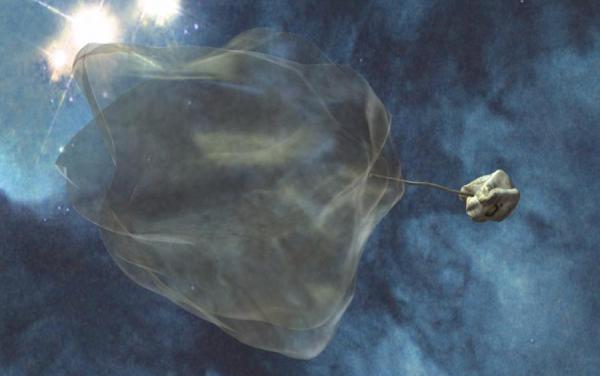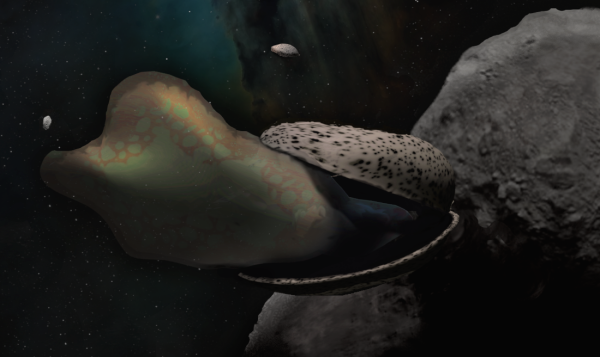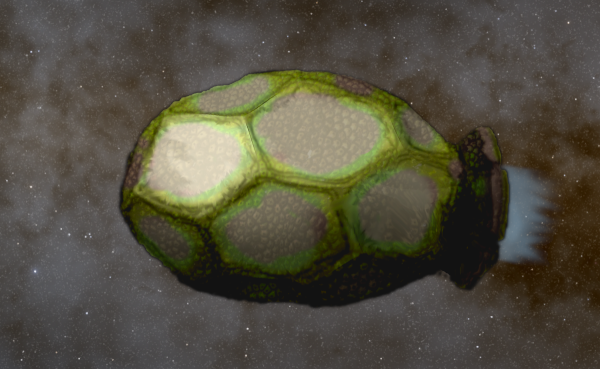BY LETTER
Cosmoamoeba, Giant Space Amoeba
Giant Space amoeba-like lifeforms | |
 Image from Steve Bowers | |
| An extended and a contracted cosmoamoeba gigas lagoonensis exchange silicoid information packets in the Trifid Nebula | |
Cosmoamoeba gigas lagoonensis
This subspecies takes the form of large shapeless blobs that vary in size from 500 meters when contracted to several tens of kilometers when extended. In their normal state they are covered in a thin semi-transparent membrane, becoming opaque when contracted and almost completely diaphanous when extended. The membrane contains a very thin gaseous fluid, in which trillions of microscale nodules, not unlike foglets are suspended. These nodules exist in various specialized subtypes, and are able to catch and metabolize micrometeors which penetrate the membrane (which rapidly seals itself when punctured). The nodules have a resilient silicon-ice metabolism that is highly redundant. They use stellar winds not only to move, but also to feed on dust following their magnetic fields.It is still not clear whether they are a natural lifeform that evolved from organic molecules in comets or protostellar nebula, or a neogen adapted to space by an unknown alien race. No trace of any alien ruins have been found in this region, not surprising given that it mostly consist of young stars and few planets, and no relic ships or alien artifacts have been discovered either.
Extended space amoebas appear to catch the solar wind from a number of nearby bright O- and B- class stars, ultimately attaining velocities (according to doppler shift analysis) of several tens of thousands of km/sec. In this way, the giant space amoebas appear to be migrating through the galaxy.
The Lagoon and Trifid populations appear to belong to the same subspecies with very minor differences, which suggests that these space organisms evolve very slowly. Genetic information for all space amoeba subspecies includes multiple copies which constantly check against each other, a characteristic which suggests an artificial origin.
Cosmoamoeba gigas auratus
 Image from Steve Bowers | |
| An auratus during the process of shedding its test | |
This shell is organized in polygonal segments to allow growth and expansion. Another notable difference is that they exhibit quorum sensing by emitting specialized pulses of far red light to signal their presence to other individuals; it is unknown why they exhibit this behavior. This amoeba gains energy by extending photosynthetic fronds through small pores in its shell to photosynthesize. When reproducing the shell is reabsorbed and the materials are split between the two allowing for two smaller shells to be formed. Unlike its relative, lagoonensis, the auratus subspecies uses chemical propulsion instead of propelling itself using the solar winds. Despite its similarities to artificially designed Neumann mining tools for asteroids and comets, from its propulsion to its mechanisms for feeding, researchers have yet to find definitive evidence of artificial origins.
Cosmoamoeba gigas testudinae
 Image from Steve Bowers | |
| An individual of the testudinae subspecies using its chemical rocket booster to migrate between stars in the Lagoon Nebula | |
Like the auratus subspecies, the testudinae manoeuvre using chemical reaction rockets. The rear of the test is specially shaped to accommodate a rocket-like thruster. The fuel used is either hydrogen and oxygen derived from water, or powdered metal (such as aluminium or iron) burned in oxygen, depending on availability.
Whether the Cosmoamoebae species are naturally-occurring organisms or relics of some long-vanished xenosophont civilisation, researchers and vacuum-life enthusiasts in the region will no doubt continue to be intrigued by their complex life-cycles and spectacular habitats.
Related Articles
Appears in Topics
Development Notes
Text by M. Alan Kazlev and Oliver
with additional material by Steve Bowers and Arik
Initially published on 31 December 2001.
Cosmoamoeba gigas lagoonensis material written by M. Alan Kazlev, 2001;
Cosmoamoeba gigas auratus material written by Oliver, 2023;
Cosmoamoeba gigas testudinae material written by Steve Bowers, 2023
with additional material by Steve Bowers and Arik
Initially published on 31 December 2001.
Cosmoamoeba gigas lagoonensis material written by M. Alan Kazlev, 2001;
Cosmoamoeba gigas auratus material written by Oliver, 2023;
Cosmoamoeba gigas testudinae material written by Steve Bowers, 2023






